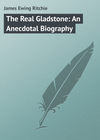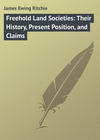Czytaj książkę: «About London», strona 3
CHAPTER IV.
HIGHGATE
If I were inclined to be dull, I would say Highgate is a village to the north of London, with an ancient history, a great deal of which the reader, if he be not a fool, can imagine, and with a very fine geological formation, indicative of salt-water where it is now very difficult to find fresh. In order, also, that I may not weary my reader, and establish a cheap reputation for a great deal of learning, I will frankly confess that Highgate, means High Gate, and nothing more. In old times, right away from Islington Turnpike-Gate to Enfield Chase, there was a magnificent forest, and part of this forest extended as far as Highgate. Down in the very heart of it, in Hornsey, the Bishop of London had a castle, and of the Park attached to it Highgate formed a part. When the old road to the north was found impassable, a new one was formed over the hill, and through the Bishop’s Park. In those days pious bishops levied toll; to collect this toll a gate was erected, and here was Highgate, and truly does it deserve the name. It is said the hill is 400 feet above the top of St. Paul’s. Be this as it may, near London, a lovelier spot is rarely to be met with. Artists, poets, parties in search of the picturesque, cannot do better than visit Highgate. At every turn you come to the most beautiful prospects. When London will consume its own smoke, if that time ever does arrive, the view from Highgate, across the great city, will be the grandest in the world. On a clear day, standing in the Archway Road – that road esteemed such a wonder of engineering in its day, and forming such a disastrous property for its shareholders (the £50 shares may be bought at about 18s. a share) – you may see across the valley of the Thames as far as the Kent and Surrey hills looming obscurely in the distance. Close to the Archway Tavern, but on the other side of the road, is a lofty old-fashioned brick mansion, said to have been inhabited by Marshal Wade, the military hero who did so much for the wars of Scotland, and whose memory is still preserved in the following very remarkable couplet:
“Had you seen these roads before they were made,
You would lift up your hands and bless General Wade.”
Well, from the top of this mansion you can see no less than seven English counties. The number seems almost fabulous, and if, in accordance with a well-established rule in such cases, we only believe half we hear, enough is left to convince us that the view is one of no common kind; all that is wanted to make the scene perfect is a little bit of water. From every part of the hill, in spite of builders and buildings, views of exquisite beauty may be obtained. Going down towards Kentish Town, the hill where her Majesty was nearly dashed to pieces by the running away of the horses of her carnage (her royal arms on a public-house still preserves the tradition and the memory of the man who saved her at the peril of his life), past where Mr. Bodkin the Barrister lives, past where William and Mary Howitt live, past where the rich Miss Burdett Coutts has a stately mansion, which, however, to the great grief of the neighbourhood, she rarely adorns with her presence, what pleasant views we have before us. It is the same going down past St. Joseph’s Retreat to Holloway; and in Swain’s Lane, another lane leading back to Kentish Town, you might fancy you were in Arcady itself. Again, stand on the brow of the hill, with your backs to London, looking far away to distant Harrow, or ancient Barnet, what a fair plain lies at your feet, clothed with cheerful villas, and looking bright and warm. “Upon this hill,” says Norden, “is most pleasant dwelling, yet not so pleasant as healthful, for the expert inhabitants there report that divers who have been long visited with sicknesse not curable by physicke, have in a short time repaired their health by that sweet salutary air.” In 1661, the Spanish Ambassador, Count Gondomar, excuses his absence from the English court on the plea that he had gone to his retreat in Highgate “to take the fresh aire.” The associations connected with Highgate are of the most interesting character. It was coming up Highgate Hill that Dick Whittington heard the bells prophesying that if he would return he would be Lord Mayor of London; a public-house still marks the spot. It was at the bottom of Highgate Hill that the great Bacon – the wisest and not the meanest of mankind, that lie is at length exploded, and must disappear from history – caught the cold of which he died. “The cause of his Lordship’s death,” writes Aubrey, who professed to have received the information from Thomas Hobbes of Malmesbury, “was trying an experiment as he was taking the air in the coach with Dr. Winterbourne, a Scotchman, physician to the king. Towards Highgate snow lay on the ground, and it came into my Lord’s thoughts why flesh might not be preserved in snow as in salt. They were resolved they would try the experiment presently. They alighted out of the coach, and went into a poor woman’s house at the bottom of Highgate Hill, and bought a hen and stuffed the body with snow, and my Lord did help to do it himself. The snow so chilled him that he immediately fell so ill that he could not return to his lodgings, but went to the Earl of Arundel’s house at Highgate, where they put him into a good bed warmed with a pan, but it was a damp bed, that had not been laid in for about a year before, which gave him such a cold, that in two or three days, as I remember, he (Hobbes) told me he died of suffocation.” The Arundel house here referred to does not seem to be the Arundel House still existing in Highgate, on the left-hand side as you come up the main road from Islington. The house now bearing that name is said to have been a residence of Nell Gwynne, and during that period was visited by the merry monarch himself. The creation of the title of Duke of St. Albans, which is related to have been obtained by Nell Gwynne in so extraordinary a manner from King Charles, is said to have taken place at this house. A marble bath, surrounded by curious and antique oak-work, is there associated with her name. As the house is now in the possession of a celebrated antiquarian, the Rev. James Yates, M.A., it is to be hoped that it will be as little modernised as possible. More hallowed memories appertain to the next house we come to.
Andrew Marvel, patriot, was born, 1620, at Kingston-upon-Hull. After taking his degree of B.A. at Trinity College, Cambridge, he went abroad, and at Rome he wrote the first of those satirical poems which obtained him such celebrity. In 1635, Marvel returned to England, rich in the friendship of Milton, who a couple of years after, thus introduced him to Bradshaw: “I present to you Mr. Marvel, laying aside those jealousies and that emulation which mine own condition might suggest to me by bringing in such a coadjutor.” “It was most likely,” writes Mrs. S. C. Hall, “during this period that he inhabited the cottage at Highgate, opposite to the house in which lived part of the family of Cromwell.” How Marvel became M.P. for his native town – how he was probably the last representative paid by his constituents, (a much better practice that than ours of representatives paying their constituents) – how his “Rehearsal Transposed,” a witty and sarcastic poem, not only humbled Parker, but, in the language of Bishop Burnet, “the whole party, for from the king down to the tradesman the book was read with pleasure,” – how he spurned the smiles of the venal court, and sleeps the sleep of the just in St. Giles-in-the-Fields, are facts known to all. Mason has made Marvel the hero of his “Ode to Independence,” and thus alludes to his incorruptible integrity:
“In awful poverty his honest muse
Walks forth vindictive through a venal land;
In vain corruption sheds her golden dews,
In vain oppression lifts her iron hand, —
He scorns them both, and armed with truth alone,
Bids lust and folly tremble on the throne.”
On the other side of the way is an old stately red-brick building, now a school, and well known as Cromwell House. I don’t find that Cromwell lived there, but assuredly his son-in-law, Ireton, did. His arms are elaborately carved on the ceiling of the state-rooms, the antique stair-case and apartments retain their originality of character, and the mansion is altogether one of very great interest. Mr. Prickett, in his History of Highgate, tells us Cromwell House is supposed to have been built by the Protector, whose name it bears, about the year 1630, as a residence for General Ireton, who married his daughter, and was one of the commanders of his army; it is, however, said to have been the residence of Oliver Cromwell himself, but no mention is made, either in history or his biography, of his ever having lived at Highgate. Tradition states there was a subterraneous passage from this house to the Mansion House, which stood where the new church now stands, but of its reality no proof has hitherto been adduced. Cromwell House was evidently built and internally ornamented in accordance with the taste of its military occupant. The staircase, which is of handsome proportions, is richly decorated with oaken carved figures, supposed to have been of persons in the General’s army, in their costumes, and the balustrades filled in with devices emblematical of warfare. From the platform on the top of the mansion may be seen a perfect panorama of the surrounding country.
On the hill was the house of Mr. Coniers, Bencher and Treasurer of the Middle Temple, from which, on the 3rd of June, 1611, the Lady Arabella escaped. Her sin was that she had married Mr. Seymour, afterwards Marquis of Hertford. Her fate was sad; she was recaptured and died in the Tower. Sir Richard Baker, author of “The Chronicles of the Kings of England,” resided at Highgate. Dr. Sacheverel, that foolish priest, died at Highgate. But a greater man than any we have yet named lived here. I speak of S. T. Coleridge, who lived in a red-brick house in the “Grove” twenty years, with his biographer, Mr. Gillman, which house is now inhabited by Mr. Blatherwick, surgeon. It is much to be regretted that Gillman’s Life was never completed, but a monument in the new church, and a grave in the old churchyard, mark the philosopher’s connection with Highgate. Carlyle has given us a description of what he calls Coleridge’s philosophical moonshine. I met a lady who remembers the philosopher well, as a snuffy old gentleman, very fond of stroking her hair, and seeing her and another little girl practise their dancing lessons. On one occasion Irving came with the philosopher. As the great man’s clothes were very shabby, and as he took so much snuff as to make her sneeze whenever she went near him, my lady informant had rather a poor opinion of the author of “Christabel” and the “Ancient Mariner.” A contemporary writer, more akin in philosophy to Coleridge than Thomas Carlyle, and more able to appreciate the wondrous intellect of the man than the little lady to whom I have already referred, says, “I was in his company about three hours, and of that time he spoke during two and three-quarters. It would have been delightful to listen as attentively, and certainly as easy for him to speak just as well, for the next forty-eight hours. On the whole, his conversation, or rather monologue, is by far the most interesting I ever read or heard of. Dr. Johnson’s talk, with which it is obvious to compare it, seems to me immeasurably inferior. It is better balanced and squared, and more ponderous with epithets, but the spirit and flavour and fragrance, the knowledge and the genius, are all wanting. The one is a house of brick, the other a quarry of jasper. It is painful to observe in Coleridge, that with all the kindness and glorious far-seeing intelligence of his eye, there is a glare in it, a light half-unearthly and morbid. It is the glittering eye of the Ancient Mariner. His cheek too shows a flush of over-excitement, the ridge of a storm-cloud at sunset. When he dies, another, and the greatest of their race, will rejoin the few immortals, the ill-understood and ill-requited, who have walked this earth.” Had Coleridge ever a more genial visitant than the farmer-looking, but eloquent and philanthropic Chalmers, who in 1839 came from Scotland to London, and of course clomb up Highgate Hill to pay a visit to Coleridge, he says – “Half-an-hour with Coleridge was filled up without intermission by one continuous flow of eloquent discourse from that prince of talkers. He began, in answer to the common inquiries as to his health, by telling of a fit of insensibility in which, three weeks before, he had lain for thirty-five minutes. As sensibility returned, and before he had opened his eyes, he uttered a sentence about the fugacious nature of consciousness, from which he passed to a discussion of the singular relations between the soul and the body. Asking for Mr. Irving, but waiting for no reply, he poured out an eloquent tribute of his regard, mourning pathetically that such a man should be throwing himself away. Mr. Irving’s book on the ‘Human Nature of Christ’ in his analysis was minute to absurdity; one would imagine that the pickling and preserving were to follow, it was so like a cookery-book. Unfolding then his own scheme of the Apocalypse – talking of the mighty contrast between its Christ and the Christ of the Gospel narrative, Mr. Coleridge said that Jesus did not come now as before, meek and gentle, healing the sick and feeding the hungry, and dispensing blessings all around; but he came on a white horse, and who were his attendants? – Famine and War and Pestilence.”
The poets have always been partial to Highgate. William and Mary Howitt live there at this day. Florence Nightingale has also there taken up her abode. The German religious reformer, Ronge, lives at the foot of Highgate Hill. Nicholas Rowe was educated there. It was in one of the lanes leading to Highgate that Coleridge met Keats and Hunt. “There is death in the hand,” said he to Hunt, as he shook hands with the author of Endymion. Painters and artists have also been partial to Highgate. George Morland would stay at the Bull, an inn still existing, weeks at a time, and, we may be sure, ran up very handsome scores. An incident that occurred to Hogarth while at Highgate made an artist of him. The tale is thus told by Walpole – “During his apprenticeship he set out one Sunday with two or three companions on an excursion to Highgate. The weather being very hot, they went into a public-house, where they had not been long before a quarrel arose between some persons in the same room; one of the disputants struck the other on the head with a quart pot and cut him very much; the blood running down the man’s face, together with the agony of the wound, which had distorted the features into a most hideous grin, presented Hogarth, who showed himself thus early apprised of the mode nature had intended he should pursue, with a subject too laughable to be overlooked. He drew out his pencil, and produced on the spot one of the most ludicrous figures that was ever seen. What rendered the piece the more valuable was, that it exhibited an exact likeness of the man, with the portrait of his antagonist, and the figures in caricature of the principal persons gathered around him.” One of the names associated with Highgate I find to be that of Hogarth’s enemy, Wilkes, patriot or demagogue. In his Life I read, “Mr. Wilkes was of the Established Church, but after he was married he often went to Meeting. He lived in a splendid style, and kept a very elegant and sumptuous table for his friends. Among the numerous persons who visited this family were Mr. Mead, an eminent drysalter on London Bridge, with his wife and daughter, who, being also Dissenters, frequently went to the Meeting-house in Southwood Lane, Highgate, in Mr. Wilkes’s coach, which was always drawn by six horses, such was his love of external appearance.” Going still further back, more renowned characters appear on Highgate Hill. After the memorable battle of Bosworth Field, in which the usurper, Richard, had been slain, it was at Highgate that the victorious Richmond was met by the citizens of London on his triumphal approach to the metropolis. “He was met,” writes Lambert, “by the Lord Mayor and Aldermen in scarlet robes, with a great number of citizens on horseback.” The Gunpowder Plot is also connected with this interesting locality. It is said, while that old villain, Guy Fawkes, was preparing “to blow up king and parliament, with Jehu and Powdire,” the rest of the conspirators had assembled on Highgate Hill to witness the catastrophe; indeed, a driver of the Barnet mail – I fear not the best authority in the world on antiquarian matters – went so far on one occasion as to point out to the writer a bit of an old wall, a little beyond Marvel’s house on the same side of the way, as a part of the identical house in which those very evil-disposed gentlemen met. A subterraneous way is also said to have existed from the site of the present church to Cromwell House, and thence to Islington. To me the story seems somewhat doubtful, but the reader is at full liberty to believe it or not as he likes. Let us now speak of the institutions of Highgate: the most modern is the cemetery, which was consecrated by the Lord Bishop of London in May, 1839, and has therefore the merit of being one of the first, as it is undoubtedly one of the most beautiful in situation, of any near London. It contains about twenty acres of ground on the side of the hill facing the metropolis. The approach to it through Swain’s Lane conducts the visitor by a green lane rising gradually to the Gothic building which forms the entrance. Entering the grounds, the eye is struck by the taste everywhere displayed. Broad gravel paths on either side wind up the steep slope to the handsome new church of St. Michael’s, which is seen to great advantage from almost every part of the grounds. An hour may be very well spent here musing on the dead. Good and bad, rogue and honest man, saint and sinner, here sleep side by side. John Sadleir, but too well known as M.P., and chairman of the London and County Bank, is buried here. Indeed all sects, and callings, and professions, have here their representative men. General Otway has one of the handsomest monuments in the grounds. One of the most tasteful is that of Lillywhite, the cricketer, erected by public subscription. Wombwell, known and admired in our childish days for his wonderful menagerie, reposes under a massive lion. One grave has a marble pillar bearing a horse all saddled and bridled. The inscription under commemorates the death of a lady, and commences thus,
“She’s gone, whose nerve could guide the swiftest steed.”
On inquiry we found the lady was the wife of a celebrated knacker, well skilled in the mysteries of horseflesh and the whip. Holman, the blind traveller, is buried in Highgate Cemetery, and very near him are the mortal remains of that prince of newspaper editors and proprietors, Stephen Rintoul. On the other side the cemetery is buried Bogue, the well-known publisher of Fleet Street. In the Catacombs are interred Liston, the greatest operator of his day, and Pierce Egan, a man as famous in his way. It was only a few months since Sir W. Charles Ross, the celebrated miniature painter, was buried here. Frank Stone sleeps in the same cemetery, as also does that well-remembered actress, Mrs. Warner. Haydn, well-known for his Dictionary of Dates, and Gilbert à Beckett, still remembered for his comic powers, are amongst the literary men that here await the resurrection morn. A fairer place in which to sleep it would be difficult to choose, in spite of the monstrous trophies of affectation, or ostentation, or affection all round, – in spite of the reminiscences of Cornhill and Cheapside, suggested by every other grave. As a ride, you had better pass by monuments unlooked at, they do but enumerate the virtues of the illustrious obscure, and the wealth of their survivors.
Of the past we now recall another relic, Lord Byron, in “Childe Harold,” writes,
“Some o’er thy Thamis row the ribbon’d fair,
Others along the safer turnpike fly;
Some Richmond-hill ascend, some scud to Ware,
And many to the steep of Highgate hie.
Ask ye, Bœotian shades! the reason why?
’Tis to the worship of the solemn Horn,
Grasped in the holy hand of Mystery,
In whose dread name both men and maids are sworn,
And consecrate the oath with draught, and dance till mom.”
In the note from whence the above extract is taken, Lord Byron says he alludes to a ridiculous custom which formerly prevailed in Highgate of administering a burlesque oath to all travellers of the middling rank who stopped there. The party was sworn on a pair of horns fastened, never to kiss the maid when he could the mistress; never to eat brown bread when he could get white; never to drink small beer when he could get strong; with many other injunctions of the kind, to all which was added the saving clause, “unless you like it best.” Lambert tells us, “the oath formerly was tendered to every person stopping at any of the public-houses of the village, which are very numerous, and mostly distinguished by a large pair of horns placed over the signs.” I need not add, no horns are seen now. When a person consented to be sworn, he laid his hand on a pair of horns fixed to a long staff, and the oath was administered. This ridiculous ceremony being over, the juror was to kiss the horns and pay a shilling for the oath, to be spent among the company to which he or she belonged. To complete the incongruous character of the ceremony, the father, for such was the style of the person administering the oath, officiated in a wig and gown, with the addition of a mask. The origin of this custom is completely lost, but it was so common at one time, that one man is said to have sworn one hundred and fifty in a day. It appears to have been the fashion to make up parties to Highgate for the purpose of taking the oath, and as a prerequisite for admission to certain convivial societies now no more, the freedom of Highgate was indispensable. The father facetiously said if the son, as the individual sworn was termed, was too poor to pay for wine himself, he was recommended to call for it at the first inn, and to place it to his father’s score, “and now, my good son,” the formula continued, “I wish you a safe journey through Highgate and this life.” If the father’s good wishes were realized, one is almost inclined to regret that the ceremony exists no longer. Another ancient institution is the grammar school, founded in 1562 by Sir Roger Cholmeley, Lord Chief Baron of the Exchequer, and after that Chief Justice of the King’s Bench.
But we must leave Highgate, now the retreat of the wealthy citizen, and the great North Road, along which coaches galloped almost every minute, and along which lords and ladies posted, ere that frightful leveller, the railroad had been formed. By the Favourite omnibuses it is but a sixpenny ride to Highgate from the Bank, but in the good old times, the fare by the stage was half-a-crown. It would do aldermen good to go up its hill, and the city clerk or shopman cannot frequent it too much. Highgate has much the air of a provincial town. It has its Literary Institution, and its police office, and water-works, and gas, its seminaries for ingenious youth of either sex, and its shops filled with miscellaneous wares. The great city is creeping up the hill, and seeking to encircle it with its chains of brick, but it resists lustily, and with its quaint old houses, and fine old trees, will not assume a cockney appearance. I honour it for its obstinacy, and trust that it will be long before it shall have the wicked, busy, towny appearance of the Modern Babylon.




















